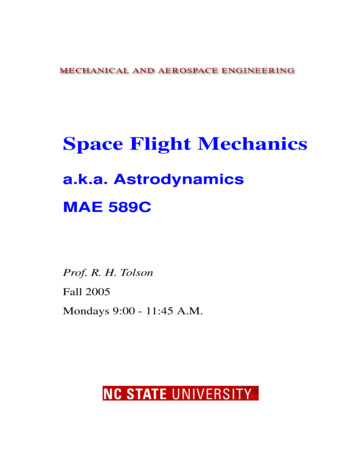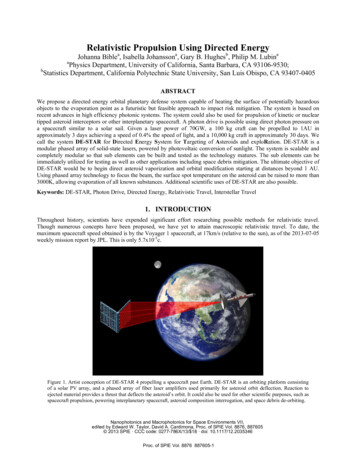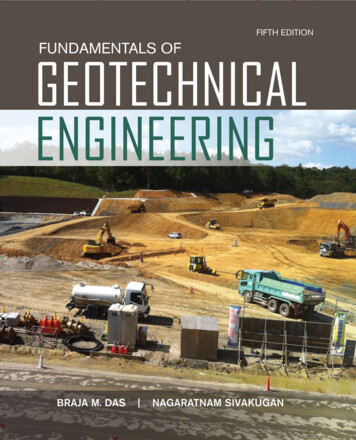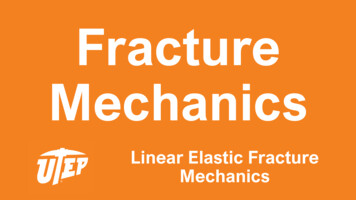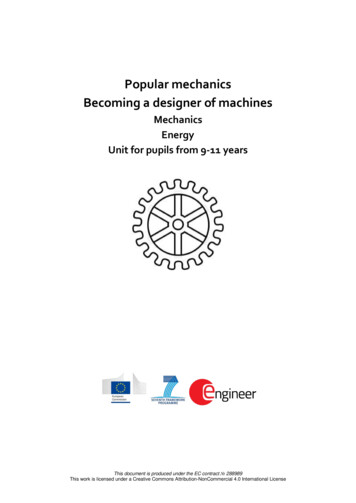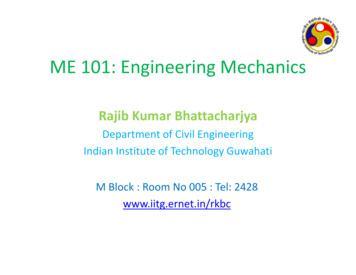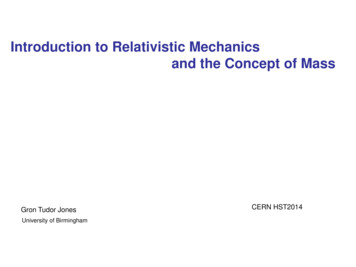
Transcription
Introduction to Relativistic Mechanicsand the Concept of MassGron Tudor JonesUniversity of BirminghamCERN HST2014
Introduction to relativistic kinematics and the concept of massMass is one of the most fundamental concepts in physics.When a new particle is discovered (e.g. the Higgs boson), the firstquestion physicists will ask is, ‘What is its mass?’Classical physics (v c)T mv2/2m 2T/v2p mvm p/vT p2/2mm p2/2TKnowing any 2 of T, p and v,one can calculate m.Same is true in relativity but weneed the generalised formulae.Before that: a brief discussion of ‘E mc2’
Einstein’s equation: ‘E mc2’E0 m c2E m c2whereE0 m0 c2E m0 c2c velocity of light in vacuoE total energy of free bodyE0 rest energy of free bodym0 rest massm massQ1: Which equation most rationally follows from special relativity andexpresses one of its main consequences and predictions?Q2: Which of these equations was first written by Einstein and wasconsidered by him a consequence of special relativity?
The correct answer to both questions is:E0 mc2(Poll carried out by Lev Okun among professional physicists in 1980sshowed that the majority preferred 2 or 3 as the answer to both questions.)‘This choice is caused by the confusing terminology widely used in thepopular science literature and in many textbooks. According to thisterminology a body at rest has a proper mass or rest mass m0, whereasa body moving with speed v has a relativistic mass or mass m, given byEm 2 cm0v21 2c‘ this terminology had some historical justification at the start of ourcentury, but it has no justification today.‘Today, particle physicists only use the term mass. According to thisrational terminology the terms rest mass and relativistic mass areredundant and misleading.
There is only one mass in physics, m, which does not dependon the reference frame.‘As soon as you reject the relativistic mass there is no need tocall the other mass rest mass and to mark it with a subscript 0.’
Letter from Albert Einstein to Lincoln Barnett, 19 June 1948m0Em It is not good to introduce the concept of massc2v21 2cmoving body for which no clear definition can be given.of aIt is better to introduce no other mass concept than the rest mass m.Instead of introducing m, it is better to mention the expression for themomentum and energy of a body in motion.
The two fundamental equations of relativistic kinematics(Relativistic generalisations of E p2/2m and p mv.)Conservation of energy and momentum are close to the heart of physics.Discuss how they are related to 2 deep symmetries of nature.All this is looked after in special relativity if we define energy andmomentum as follows:E2 p2c2 m2c4andp vEc2where E total energyp momentumv velocitym ordinary mass as in Newtonian mechanicsNext: hope to persuade you to accept these equations.
* E0 mc2Consider E2 – p2c2 m2c4 . For the situation when the particle is atrest (v o), the energy E is the rest energy E0 and p 0.So, E0 mc2* Show that, for v c, E mc2 p2/2m mc2 mv2/2Firstly, when v c, p vE0c2 v m. Also,E (p2c2 m2c4)1/2 mc2 (1 p2c2/m2c4)1/2 mc2 (1 p2c2/2m2c4 )For v c, p2c2 m2c4.So, E mc2 p2/2m E0 mv2/2RestenergyNewtoniankinetic energyThe relativistic equationsfor p and E reduce to theNewtonian ones for v c;so the m in them is theNewtonian mass.
* Consider the extreme ‘anti-Newtonian’ limit where m 0If m 0, thenvE v p 2 c 2vpp 2 cc2c v cSuch bodies have no rest frame; they always move withthe speed of light.Also m 0 E pcMassless bodies have no rest energy, just KE.(e.g. photon.graviton)Our two expressions for p and E describe the kinematicsof a free body for all velocities from 0 to c; and alsoE0 mc2 follows from them.
Back-up slides on relativistic kinematics
21 2 v 2 Ek mv Ek 2 2 c mc NEWTONIAN2 2Ev 222 22 4E p c m c 4 c m2c 4c mcv 2 1 2c E222 mc v 2 1 2 c Ek mc 222RELATIVISTICSpeed and Kinetic Energy for Relativistic Electrons by William Bertozzi(American Journal of Physics 32 (1964) 551-555)
Speed of 7 TeV proton22 4vmcSubstitute p vE/c2 into E2 p2c2 m2c4 to get 1 2 cE2For E 7000 GeV proton (mc2 0.938 GeV) E pc (approx);i.e. speed is exceedingly close to c.So (1 – v2/c2) (1 - v/c)(1 v/c) 2(1 – v/c) to high accuracyHence (1-v/c) (mc2)2/2E2 0.9382/(2 x 70002) 0.9 x 10-8And v 0.999999991c
Invariant (‘effective’) mass of two photonsE1,p1AE2,p2m122 c4 (E1 E2)2 - (p1 p2)2 c4 E12 E22 2E1E2 – p12 c2 – p22 c2 - 2p1p2 c2Now, for photons, E pc, so E2 – p2c2 0, andm122 c4 2p1 p2 c2 (1 – cos A)Consider A 0 and A 180o
popular science literature and in many textbooks. According to this terminology a body at rest has a proper mass or rest mass m 0, whereas a body moving with speed v has a relativistic mass or mass m, given by 2 2 0 2 1 c v m c E m ' this terminology had some historical justification at the start of our century, but it has no .

